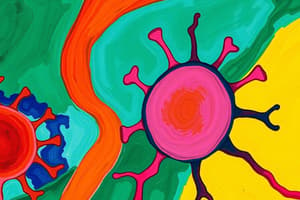Podcast
Questions and Answers
What is the range of pollen size?
What is the range of pollen size?
- 60 to 200 μm
- 10 to 60 μm
- 200 to 300 μm
- 10 to 200 μm (correct)
What is the definition of pollination?
What is the definition of pollination?
- The transfer of pollen from the stigma to the anther sac
- The transfer of pollen from the female portion to the male portion of the same or another flower (correct)
- The transfer of pollen from the anther sac to the male portion of the same or another flower
- The transfer of pollen from the female portion to the stigma of the same or another flower
Which grass subfamily shows strong cross-allergenicity based on homology of three major allergens with possible unique allergens in Timothy and sweet vernal?
Which grass subfamily shows strong cross-allergenicity based on homology of three major allergens with possible unique allergens in Timothy and sweet vernal?
- None of the above
- Panicoideae
- Chloridoideae
- Pooideae (correct)
Which grass is cross-reactive with other members of the subfamily Chloridoideae, but not with the other subfamilies?
Which grass is cross-reactive with other members of the subfamily Chloridoideae, but not with the other subfamilies?
What are the principal methods of volumetric air sampling?
What are the principal methods of volumetric air sampling?
What is the difference between monoecious and dioecious plant species?
What is the difference between monoecious and dioecious plant species?
What is the importance of the abundance of pollen production?
What is the importance of the abundance of pollen production?
What is the principle method used in volumetric sampling?
What is the principle method used in volumetric sampling?
How many major allergens are there in the fourteen grass allergen groups that have been characterized?
How many major allergens are there in the fourteen grass allergen groups that have been characterized?
What is the staining solution used to examine pollen and spores under a microscope?
What is the staining solution used to examine pollen and spores under a microscope?
How are pollen and mold spores identified?
How are pollen and mold spores identified?
What is the measurement used to determine the degree of elongation of pollen and spores?
What is the measurement used to determine the degree of elongation of pollen and spores?
What is the transfer of pollen from the male to the female portion of a flower called?
What is the transfer of pollen from the male to the female portion of a flower called?
What are Thommen's Postulates of Allergenicity?
What are Thommen's Postulates of Allergenicity?
What are the two ways pollen can be pollinated?
What are the two ways pollen can be pollinated?
What is required for an allergenic response?
What is required for an allergenic response?
Flashcards are hidden until you start studying
Study Notes
- Antigens are recognized by the immune system and can generate a specific immune response
- Haptens require a carrier protein to stimulate an initial antibody response
- Adjuvants are necessary to achieve maximal adaptive immune response to a vaccine
- Superantigens cause massive cytokine release and can lead to cytokine storm
- MHC molecules are involved in antigen presentation and immune responses
- CD8 only recognizes MHC class I molecules, CD4 only recognizes MHC class II molecules
- MHC molecules are highly polymorphic and encoded on chromosome 6
- Antigen processing occurs through specific pathways and is presented with MHC class I or MHC class II molecules
- Conjugated vaccines trigger a T-dependent response and memory
- Understanding antigen composition and factors influencing immunogenicity and tolerogenicity is critical to immunization development.- MHC class I pathway involves chaperone proteins, proteasome, and TAP proteins
- Viruses can evade MHC class I presentation
- MHC class II pathway involves phagosomes, MHC class II vesicle, and HLA-DM
- Cross-presentation is important for CD8+ T cell responses to viruses and tumors
- Bare Lymphocyte Syndromes are primary immune deficiencies due to lack of MHC expression
- Central tolerance occurs in primary lymph organs and involves negative selection or regulatory T cell development
- Peripheral tolerance occurs in peripheral lymph tissues and involves anergy, apoptosis, or regulation
- Regulatory T cells play a critical role in maintaining normal immune function
- Tolerance is maintained by resting or immature DCs presenting self-antigen on their surfaces
- Treg development depends on the binding affinity between the TCR and self-peptide/MHC II complex.1. Treg cells are important for immune tolerance and regulation.
- Apoptosis plays a key role in regulating self-reacting T lymphocytes.
- Peripheral B-lymphocyte tolerance is maintained through anergy and apoptosis.
- DNA is composed of nucleotides and organized into a double helix.
- Genetic mutations can occur at the genomic, mitochondrial or RNA level.
- GWAS is a tool used to identify genes associated with disease.
- Epigenetics refers to modification of gene expression or repression.
- Ig is the key component of humoral immunity.
- Variable regions of Ig form the antigen-binding sites.
- Enzymatic cleavage of Ig produces fragments with different functions.- Immunoglobulins (Ig) are proteins that recognize and bind to antigens.
- Different forms of Ig exist, including membrane-bound and secreted.
- IgM is the first Ig produced after birth and the first to be synthesized following antigenic stimulation.
- Only IgG crosses the placenta, and it has the longest half-life of all Ig subclasses.
- IgA is produced in the highest quantity daily and is found in higher concentrations in the respiratory and GI mucosal surfaces.
- The only Ig to cross the placenta is IgG.
- The Ig class with the highest plasma concentration is IgG, and the Ig class with the highest total body concentration and daily production is IgA.
- Ig can recognize highly diverse antigens through linear and conformational determinants found in various macromolecules.
- Ig-mediated effector functions include neutralization of microbes or toxins, opsonization, ADCC, and immediate hypersensitivity (IgE).
- Somatic hypermutation leads to changes in the V, not the C regions. Diversifies BCR’s used to recognize antigen.
Studying That Suits You
Use AI to generate personalized quizzes and flashcards to suit your learning preferences.




